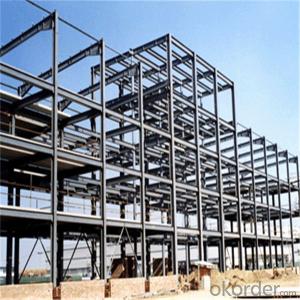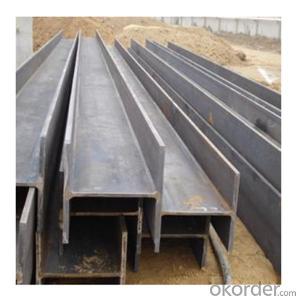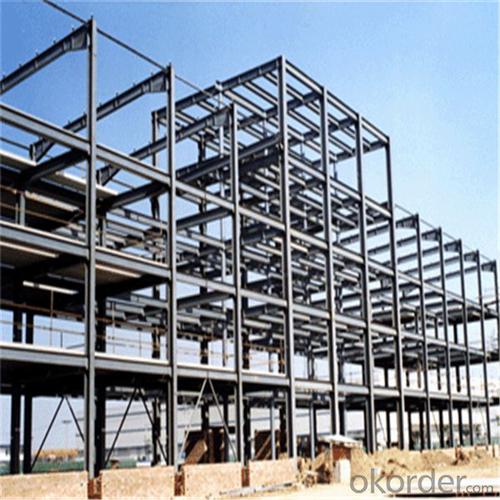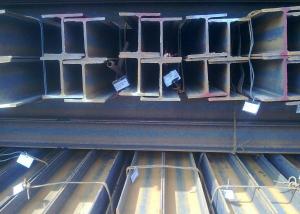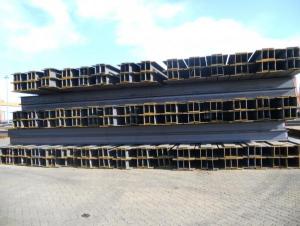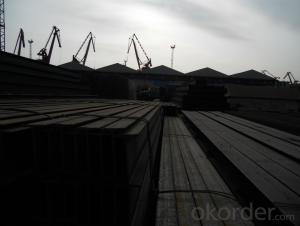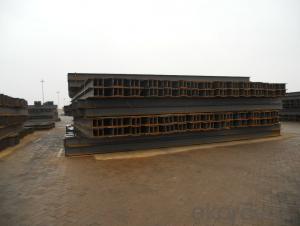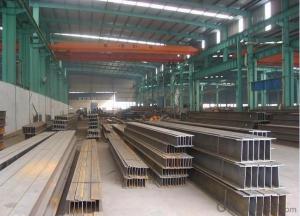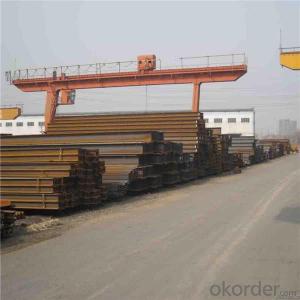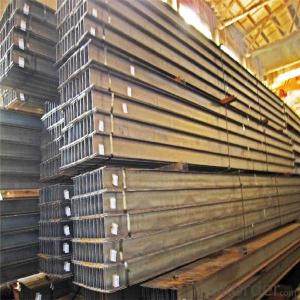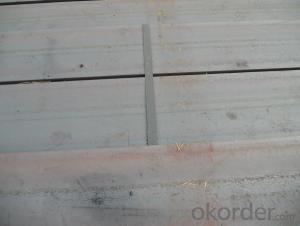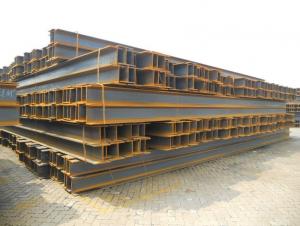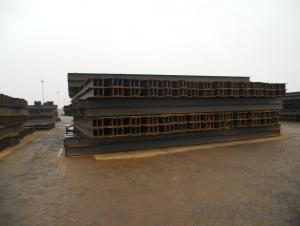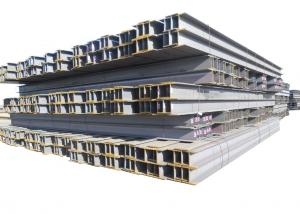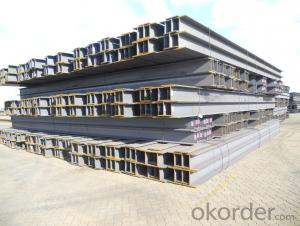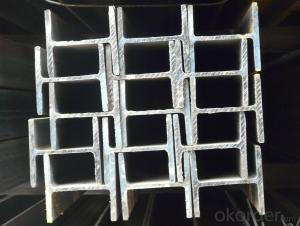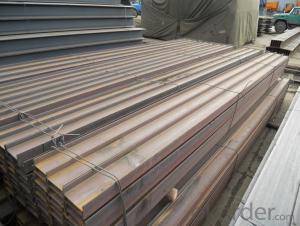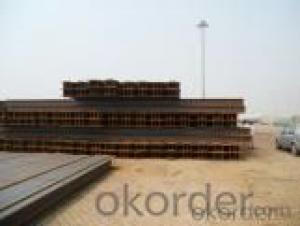European Standard Structural H Steel Beams Price per Kg
- Loading Port:
- Hai Kou
- Payment Terms:
- TT OR LC
- Min Order Qty:
- 100 m.t
- Supply Capability:
- 150000 m.t/month
OKorder Service Pledge
OKorder Financial Service
You Might Also Like
Specification
Quick Detail
OKorder is offering H BEAM at great prices with worldwide shipping. Our supplier is a world-class manufacturer of steel, with our products utilized the world over. OKorder annually supplies products to African, South American and Asian markets. We provide quotations within 24 hours of receiving an inquiry and guarantee competitive prices.
Standard: | ASTM, GB, JIS | Grade: | Q235Q345ss400ss490 | Dimensions: | HM100*100*6*--8#428*407*20*35 |
Place of Origin: | Hebei, China (Mainland) | Brand Name: | JINXI | Type: | Alloy Structural Steel |
Application: | roof beam | Shape: | Beams | price: | competitive |
We can provide qualify goods,competitive price and speedy delivery.
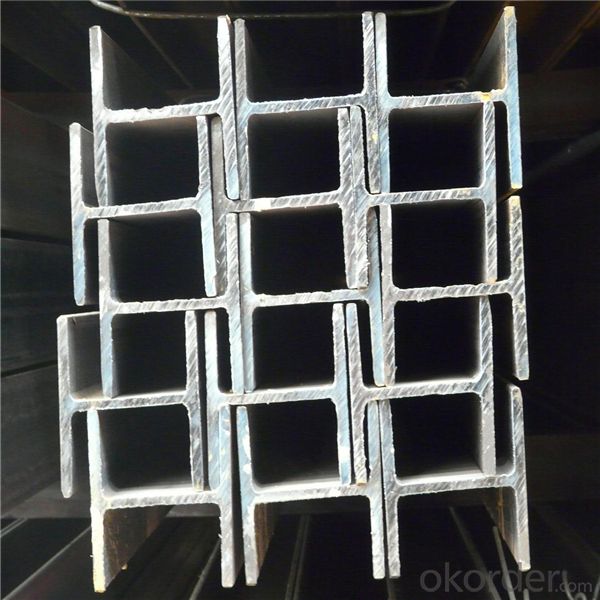
Products Description
Description | High Frenquency Thin-walled H Beam | |
Product Name | H Beam | |
Specification | Height:75-500mm Width:50-250mm | |
Standard | GB700-1998,GB/T1591-1994 | |
Material | Q235B,Q345B | |
Application | a. Bridge and post structures in industry and civil use of steel construction. | |
Certificates | ISO,SGS,BV,TUV,Lloyd | |
MOQ | 20 tons or according to customers’ requirement. | |
Port of Delivery | Tianjin Port of China | |
Remarks | We can provide qualify goods,competitive price and speedy delivery |
Packaging & Delivery
Packaging Details: | Packed with waterproof paper and steel banding. |
Delivery Detail: | 15-25 |
FAQ
1. How can I get some samples?
We are honored to offer you samples. New clients are expected to pay for the courier cost. The samples are free for you.
2 Do you have any certificates?
Our products passed inspection of SGS, FDA, and CE Quality is priority! Every worker keeps the QC from the very beginning to the very end, Quality control department especially responsible for quality checking in each process.
3 Can your factory print or emboss my logo on the goods?
Yes, we can print or emboss the logo on the goods or their packing box.
4 What information should I let you know if I want to get a quotation?
1) The specification of products (length x width x thickness);
2) The temper and alloy.
3) The final product you will use to be made
4 It will be better if you can show us the pictures or design sketch. Samples will be best for clarifying. If not, we will recommend relevant products with details for reference.We usually produce goods based on customers
Samples or based on customers’ picture, logo, sizes etc.
- Q: How do Steel H-Beams perform in terms of sound insulation?
- Steel H-Beams, commonly used in construction, do not provide significant sound insulation properties. Due to their structural design and material composition, steel H-beams are primarily used for their load-bearing capabilities rather than for soundproofing purposes. Sound insulation is typically achieved through the use of specialized soundproofing materials such as acoustic panels, insulation batts, or resilient channels. Therefore, if sound insulation is a priority, additional measures such as these should be implemented alongside steel H-beams.
- Q: Can steel H-beams be used in the construction of power plants?
- Yes, steel H-beams can be used in the construction of power plants. Steel H-beams are commonly used in construction due to their strength, durability, and ability to support heavy loads. In power plant construction, where structural integrity is crucial, steel H-beams are often used as structural elements for supporting large equipment, platforms, and structures, ensuring the stability and safety of the power plant.
- Q: How do steel H-beams contribute to energy-efficient building designs?
- Steel H-beams contribute to energy-efficient building designs due to their high strength-to-weight ratio, which allows for the creation of structurally efficient buildings. The use of H-beams allows for the construction of longer spans and taller buildings, reducing the need for additional support columns and minimizing energy loss. Additionally, their durability and resistance to bending or warping ensure long-term stability, reducing the need for maintenance or replacement.
- Q: Can steel H-beams be used for supporting heavy machinery?
- Indeed, heavy machinery can be effectively supported by steel H-beams. These H-beams are specifically engineered to possess exceptional strength and durability, rendering them exceptionally suitable for bearing substantial loads. Their robust load-bearing capacity has established their widespread application in the construction and industrial sectors, particularly for bolstering heavy machinery like cranes, gantries, and large equipment. The structural configuration of H-beams enables efficient distribution of weight, guaranteeing stability and safety during the support of hefty loads. Furthermore, steel H-beams exhibit remarkable resistance against deformation, corrosion, and various environmental elements, thereby solidifying their reputation as a dependable choice for sustaining heavy machinery.
- Q: How do steel H-beams perform in structures with large spans and cantilevers?
- The excellent strength-to-weight ratio and structural stability of steel H-beams make them widely used in structures with large spans and cantilevers. These beams can withstand heavy loads and provide maximum support over extended distances. Applications such as bridges, stadiums, warehouses, and industrial buildings benefit from the superior load-bearing capacity of steel H-beams. They allow for longer distances between support points, thanks to their H-shape that provides increased strength and rigidity against bending and deflection under heavy loads. Steel H-beams are also beneficial for cantilevers, as their inherent strength allows for longer cantilever lengths without compromising structural integrity. This is particularly useful in architectural designs that require open spaces or unique configurations, like cantilevered balconies, overhangs, or roof extensions. Construction methods and connections are made easier with steel H-beams, as they can be easily welded or bolted together. Their wide flanges provide ample surface area for attaching other structural components, such as columns, girders, or floor systems. Furthermore, steel H-beams offer excellent resistance to fire, corrosion, and weathering, making them suitable for both indoor and outdoor applications. Their durability ensures long-term performance and minimal maintenance requirements. In conclusion, steel H-beams are an ideal choice for structures with large spans and cantilevers. Their strength, stability, and versatility make them highly effective in supporting heavy loads and achieving architectural designs that require extended distances or unique configurations.
- Q: Can steel H-beams be used in temporary supports during construction?
- Yes, steel H-beams can be used in temporary supports during construction. Steel H-beams are commonly used in construction due to their strength and load-bearing capabilities, making them suitable for temporary support structures.
- Q: Can steel H-beams be used in outdoor applications?
- Yes, steel H-beams can be used in outdoor applications. Steel H-beams are known for their strength, durability, and resistance to environmental conditions, making them suitable for various outdoor projects. These beams are often used in the construction industry for applications such as bridges, retaining walls, and building structures. Additionally, they can withstand exposure to moisture, extreme temperatures, and other elements without significant deterioration or loss of structural integrity. Therefore, steel H-beams are a reliable choice for outdoor applications where strength and longevity are crucial.
- Q: Are steel H-beams suitable for use in the construction of government institutions or buildings?
- Indeed, steel H-beams prove to be a suitable option when it comes to constructing government institutions or buildings. Their strength, durability, and versatility make them a common choice in construction projects. They offer structural support and stability, making them an ideal choice for government buildings that necessitate extensive open spaces and high load-bearing capacities. Moreover, steel H-beams can be easily customized to meet specific design requirements and can withstand harsh weather conditions. Additionally, their utilization in construction projects guarantees long-term structural integrity and reduces maintenance costs. All in all, steel H-beams are a dependable and popular preference for government buildings, as they provide the required strength and stability for such structures.
- Q: What are the mechanical properties of steel H-beams?
- The mechanical properties of steel H-beams include high strength, stiffness, and durability. They have excellent load-bearing capacity, making them suitable for structural applications. Additionally, steel H-beams exhibit good resistance to bending, torsion, and compression forces. The specific mechanical properties may vary depending on the grade and composition of the steel used.
- Q: How do steel H-beams compare to concrete beams in terms of cost and durability?
- There are distinct differences in cost and durability between steel H-beams and concrete beams. In terms of cost, steel H-beams are generally more affordable. This is because steel is readily available and the manufacturing process for H-beams is efficient, resulting in lower production costs. Additionally, steel H-beams can be fabricated off-site and delivered to the construction site, reducing labor costs and construction time. On the other hand, concrete beams require on-site casting, which can be time-consuming, and the materials involved in concrete beam construction can be more expensive. When it comes to durability, both steel H-beams and concrete beams have their strengths. Steel has high tensile strength, allowing it to withstand heavy loads and resist bending or warping. This makes steel H-beams a popular choice for structures that require long spans or have large load-bearing requirements. Concrete, on the other hand, has excellent compressive strength, making it suitable for withstanding vertical loads. Concrete beams also have the advantage of being fire-resistant, which is important in certain applications. However, it is important to note that steel is susceptible to corrosion if not properly protected. Without appropriate coatings or maintenance, steel H-beams can rust and deteriorate over time, reducing their durability. In contrast, concrete beams have a longer lifespan and are less prone to corrosion. Once properly cured, concrete beams can withstand environmental factors and have a longer service life compared to steel. In conclusion, steel H-beams offer cost advantages due to their affordability and ease of fabrication, while concrete beams are generally more durable with a longer lifespan. The choice between the two materials ultimately depends on the specific requirements of the project, including load capacities, span lengths, and environmental factors.
Send your message to us
European Standard Structural H Steel Beams Price per Kg
- Loading Port:
- Hai Kou
- Payment Terms:
- TT OR LC
- Min Order Qty:
- 100 m.t
- Supply Capability:
- 150000 m.t/month
OKorder Service Pledge
OKorder Financial Service
Similar products
Hot products
Hot Searches
Related keywords
